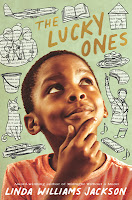May 3rd 2022 by Balzer & Bray/Harperteen
E ARC provided by Edelweiss Plus
Riley is in fifth grade and is having trouble making friends, now that the people she used to hang out with are gone. She is frequently in trouble in class for wearing her hat, talking loudly, or doodling instead of doing her work, and finds it somewhat difficult to connect with others. There is a new boy, Aaron, whose dads own the local comic book store, and Cate, who has interests other than just talking about crushes. Riley is also very interested in comic Jo Powers, but few of the other children know who this is. When Riley's class is assigned to write a letter to someone they find inspiring, she choses Jo Powers, but struggles with what to say. Cate offers to help, and the two start to hang out together. Cate is also friends with the other girls in the class, but they are quite mean to Riley. They call her "lesbo" and make fun of her, especially after she cuts her own hair very short. They don't want to invite her to the sleepover for all of the girls in the grade because they claim that having her there would be like having a boy there. (Riley also affects a traditionally more masculine mode of attire.) After meeting Aaron's dads, and realizing that she has a crush on Jo Powers, Riley starts to wonder if she is gay. She wants to talk to Aaron's dads, but he doesn't want anyone in their class to know about them quite yet. When she accidentally tells the class about them, Aaron is angry with her. Because her parents have promised that she can take an art class if she can stay out of trouble and keep her grades up, Riley has tried to do better at school, but when the kids in class give her a hard time, she gets into another fight. Her parents are fairly understanding (as is an older brother), and getting a letter from Powers helps her spirits as well.
Strengths: Even though Riley is having problems, she still is fairly upbeat, and the color palette reflects that with sunny yellows and blues. Her parents don't quite understand her, but try to work with her rather than punish her for things like cutting her own hair. (They offer to help trim it a bit, and put forward the opinion that it's a bit drastic, but are otherwise okay with it.) While a good number of the children in her class are mean, she does at least have support from Aaron, who gets her sense of humor, and Cate, who sticks up for her with the mean girls. Riley's questioning, and wanting to seek help from Aaron's dads, seems realistic, and the treatment she recieves at school is also, sadly, probably true to form.
Weaknesses: This is a weakness for my own collection, but a plus for elementary ones. The structure of the classes, lunch, and recess, as well as the interactions with classmates, all seems more appropriate to elementary school. Middle school students have their time structured differently, and interact in sneakier and more sneaky, hurtful ways.
What I really think: This is a bit young for my students, but a good choice for elementary schools that want to add to their collection of LGBTQIA+ titles. This is a good choice for young readers who have moved beyond picture books but aren't quite ready for more middle school titles.
Knisley, Lucy. Apple Crush (Peadpod Farm #2)
Weaknesses: This is a weakness for my own collection, but a plus for elementary ones. The structure of the classes, lunch, and recess, as well as the interactions with classmates, all seems more appropriate to elementary school. Middle school students have their time structured differently, and interact in sneakier and more sneaky, hurtful ways.
What I really think: This is a bit young for my students, but a good choice for elementary schools that want to add to their collection of LGBTQIA+ titles. This is a good choice for young readers who have moved beyond picture books but aren't quite ready for more middle school titles.
Knisley, Lucy. Apple Crush (Peadpod Farm #2)
May 3rd 2022 by Random House Graphic
Preview provided by Netgalley
Jen and Andi spend weekends working at a neighboring farm that has a pumpkin patch and haunted hayride. I will be ordering this sequel to Stepping Stones, but probably won't get the copy until this summer. I wanted to mention it because it was a very successful choice for one of my students who is a struggling reader and who has been dealing with some similar step parent issues this school year. She loved it so much, and it's been a popular title with my students.
























